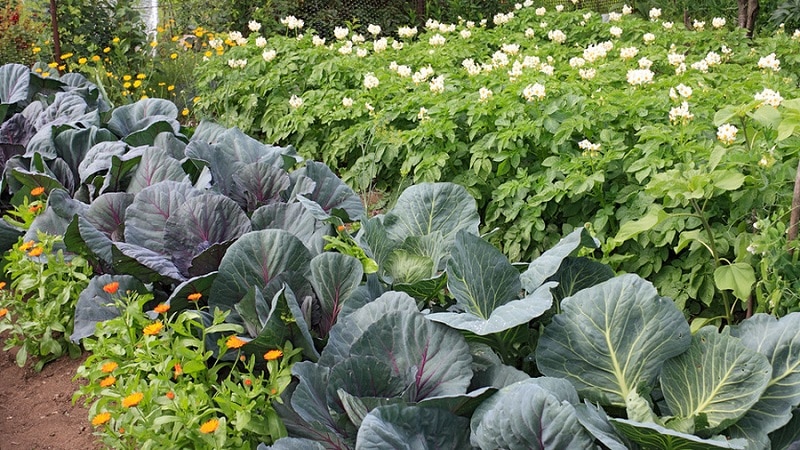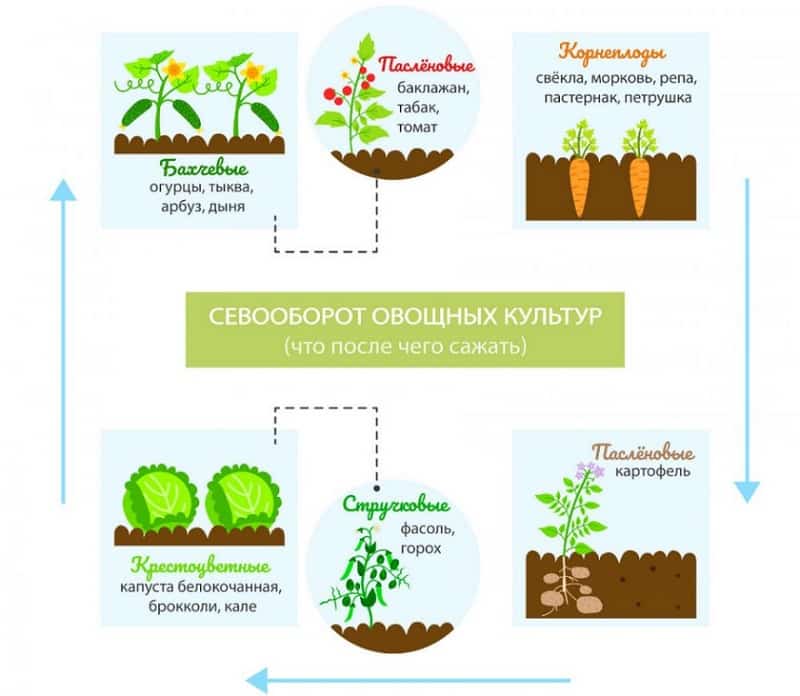What can you plant after cabbage next year?
Experienced gardeners begin to think through a plan for planting crops for the next year in advance. They know that future productivity depends on proper crop rotation. We will tell you what can be planted after cabbage next season, and what crops cannot grow there.
What can you plant after cabbage next year?
Cabbage has a powerful root system that goes deep into the ground. It takes nutrients not only from the upper, but also from the lower layers of the soil. This vegetable especially requires nitrogen, potassium, calcium and organic fertilizers in large quantities. Not every crop can grow in depleted soil, so the choice must be made responsibly.
Attention! Cabbage is susceptible to many diseases and pests that remain in the ground after harvest. Choose crops that are resistant to them to plant in its place.
Do not plant cruciferous vegetables, which include all types of cabbage, in the same place every year., turnip, radish, daikon, mustard, radish, rutabaga, turnip, rapeseed, horseradish. Otherwise, they will encounter diseases and pests that are dangerous to their family and will not produce the harvest you expect. They should be returned to the same place no earlier than after 3-4 years.
Unpretentious plants do well in the cabbage bed, as well as vegetables that require a different nutritional composition.

After cabbage, the soil is suitable for growing the following crops:
- potato;
- carrot;
- cucumbers;
- tomatoes;
- pepper;
- onion;
- garlic;
- beans;
- peas;
- beans;
- beet;
- eggplant;
- zucchini;
- squash;
- pumpkin;
- salad;
- physalis;
- dill;
- celery;
- watermelon;
- melon;
- parsley;
- spinach.
You should not rely only on observing crop rotation. To grow vegetables, first take care of fertilizing the beds. For example, for tomatoes, the soil is fed in the fall with superphosphate and potassium salt, 25 g per 1 sq. m. m, and also add humus in the amount of 5 kg per 1 sq. m.
Zucchini also needs to be fertilized. For 1 sq. m. you will need 8 kg of humus, 15 g of potassium fertilizer and 30 g of superphosphate.
Interesting things on the site:
Is it possible to plant after cabbage?
Crop rotation depends not only on what pests garden crops are susceptible to, but also on how much nutrients the plants consume and what kind of soil they leave behind. Maintaining the correct rotation of vegetable crops contributes to more effective control control pests, rational use of fertilizers and increasing productivity.
Onion
The best precursors for onions are plants that are generously fed with organic fertilizers.. And cabbage is one of them.
Onions are planted before winter after plants that loosen the soil well. Since the root system of cabbage goes deep into the ground, after harvesting it the soil is loosened. Beds cleared of heads of cabbage are an excellent place for planting winter onions.
Reference. If the cabbage is sick with something, sowing onions in its place helps disinfect the soil, as it has antimicrobial properties. If you grow onions in this place for two years, it will completely clear the soil of pathogens.
Strawberries or wild strawberries
Is it possible to plant strawberries after cabbage? Usually, beds are prepared for garden strawberries and wild strawberries in the expectation that the berries will grow in one place for at least four years. To grow them, you need fertile soil rich in microelements. Due to the fact that cabbage takes a large amount of nutrients from the ground, it is considered a bad precursor for wild strawberries.. They should also not be planted next door, because large cabbage leaves will block the sun and the berries will not receive enough light and heat.
Reference. If you still decide to plant these berries in the bed where cabbage grew before, first apply a large amount of fertilizer there.
But still, the best predecessors for strawberries are green manure, onions, garlic, legumes, herbs, carrots, and radishes.

cucumbers
After any type of cabbage - cauliflower, broccoli, red and white - cucumbers grow very well. Since cabbage belongs to the cruciferous family, and cucumbers belong to the pumpkin family, they are attacked by various pests and diseases. Therefore, cucumbers are not afraid of the harmful environment that remains after the previous planting. But the soil loosened by cabbage roots will have a positive effect on their development.
Reference. If you have an early variety of cabbage, after harvesting you will have time to occupy a bed for cucumbers in the same season.
Carrot
Carrot - not a particularly whimsical culture. The soil is rested after cabbage. It contains a sufficient amount of nutrients for the full development of carrots. That's why carrots can be sown the next year after cabbage.
Important! Cabbage and carrots are susceptible to the same disease - gray mold, which usually appears in wet weather.That is why they cannot be planted next door. If you notice gray rot in cabbage, do not plant carrots in its place next year.
Potato
Potatoes and cabbage do not have similar diseases. All its types are excellent as predecessors for potatoes, as well as their successors in crop rotation. It acts as a medicine and, like other nightshade crops, clears the soil of fungal spores of cabbage clubroot, which causes the formation of swollen growths on the roots. It takes three years to clear the soil of this pathogen from potatoes.
Read also:
Conclusion
If you think about the placement of crops in the beds in advance, it is easy to follow all the principles of crop rotation. If you think about this in the fall, you will have time to prepare a place for the next plant. Despite the fact that after cabbage leaves pests, pathogens and few useful substances in the soil, there are enough options for filling the site. The best choices would be cucumbers, potatoes and onions. Following the recommendations and careful care will help you grow an excellent harvest.